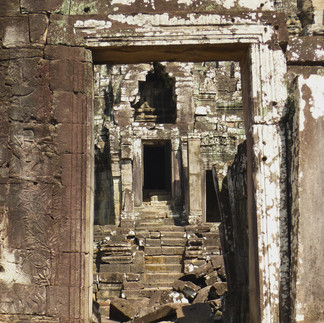Cambodia: Wat to see
- Bev Baraka
- Feb 13, 2022
- 9 min read
Cambodia is one of a kind - the history, the beauty, the people, the location. While there is a lot to see in Cambodia you can't really say you've visited Cambodia unless you've seen Angkor Wat just outside of Siem Reap. This is the largest religious complex in the world and has over 1000 buildings. The primary one that is basically thought of as Angkor Wat has a large pointed temple which is referred to as 'temple mountain' and was built for the Hindu god Vishnu as a spiritual home. This structure is on the Cambodian flag and is the most recognizable complex of the area.

You can't see the whole complex by foot as it is spread through the jungle and you need to have a tour guide show you the various temples and locations. Once you are there you might notice differences between the temples - I'm not even sure if that is what the different sections are called. None of them are ONE building but more of a compound in close proximity to another compound. That in itself is unique. It's like a conference center but it is from early in the 12th century.
Let's see some of the different temples of Angkor:

Baneay Srei: the red temple or more correctly rose-pink. This small temple is farther away, a 30 minute drive, but is well worth a visit because of the floral motifs and inspiring stories shown in the carving. It is made of rose sandstone that has very fine grains and thus shows delicate designs and motifs carved in its walls and supports. It has the typical high pointed roofs over the temple rooms. Because it has some of the finest carvings it is sometimes referred to as the art gallery of Angkor.

The delicate blush of the stonework is beautiful in the morning and late sun. In the heat of the day it is on fire -- red hot. The design of the architecture and decorations across its walls show more of an Indian influence than the Khmer as the other complexes do. You might see this temple labelled as the 'citadel of women' as that is the direct translation. It is also thought that many of the carved reliefs are so delicately done that they could not have been done by the hand of a man.

Ta Prohm: The temple from Tomb Raider and also the most unique of Buddhist temples because it is slowly being swallowed by the jungle. Huge trees wrap their roots around the structures and embed themselves in the stones. It is hard to see where the buildings end and the jungle starts. Dappled shade covers the temple, cooling it enough to invite visitors to wander and rest on the fallen stones and wrinkled roots. Some walls have been shattered by the weight of the trees growing through them while others are held up by the trees themselves.
You can still wander through the corridors and rooms but you will find some are now impassable due to crumbling walls and fallen stone blocks. Behind the front entrance is where you really find the overgrown temple metamorphizing into jungle. The dimensions of the trees dwarf the structure itself even though it would look quite impressive in a clearing on its own. Knowledge about its history comes from a stone inscription found there, written in Sanskrit. The occupants as well as the carvings on the stones within the temple are explained. Some reliefs can still be identified while others are worn off from exposure to the elements and crumbling stone.
I was totally enthralled by this temple. I love nature and I love to see it taking back the land, as it were, to regain area for the jungle and organisms that live in it.
Bayan: the temple of the faces. This iconic temple is a sea of gigantic stone faces carved into over 50 gothic style towers built up from the upper terrace of the structure. The expressions on each face are similar and are said to represent the bodhisattva of compassion, Avalokitesvara but others say the face resembles King Jayavarman VII ordered by him - showing he believed himself a 'god-king'. Look closely at the picture below to discern the faces on the vertical surfaces. It almost looks like they were somehow photoshopped into a photo of old ruins.

At first you might see one face, but as you look at each tower you will see either a smiling face or a profile. Most of the flat expanses have a face carved into the surface. Each tower has a face on the four compass sides so that you see a face no matter where you are within or outside the temple. How did they carve the faces? Did they carve them on the ground and then lift the stones to their place on the tower? If you see a face up close you can see it is made from blocks -- some blocks run smoothly to the next while others look like they have slipped and are slightly out of place, distorting the face ever so slightly.
Once you get past all the faces, you can see the complex itself is huge. The terraces run within the towers and give awesome views of the faces as you wander around. The area around the temple is also dense jungle, with few protective walls holding it back. The main direction of the temple is east and so the dominant faces meet the morning sun as it climbs to its zenith. More faces are drenched in light as the sun climbs.


Even the area around this temple has structures with the same carved faces. One such structure forms a doorway or gate to the vast area and it shows a little more of how it was constructed by stepping inside and looking up at the peaked area inside.
Along the bottom walls of the temple on the outside is a diorama of the history of the place as well as the story of the Buddha. This diorama is extensive and seems to go on forever - covering the whole exterior foundation. I don't even know how far it stretched. I got so engrossed in trying to figure out the story I got lost in it. I have a few pictures of that story as a relief on the stone. You can see above that it is also made up of blocks -- were they carved before putting up or after? The detail is extraordinary. You can see the men were fishing, as evidenced by fish in the water, and one was grabbed by a crocodile. Amazing! And this is just a tiny portion of the wall.

Angkor Thom: the fortified city with a moat! This was actually thought to be the last important capital of the Khmer empire. It covers over 10 km sq and has a wall around that averages 8 meters high. Five gates give access to the 'city' with two on the east side and one on each of the other cardinal directions. The gate that is probably the best access (mind you I didn't try the other gates) is the south gate. The gates themselves have large towers atop them (see the picture above) and these have faces on them similar to the faces on the Bayan temple. These gates give access by a causeway or bridge across the moat. Each side of the bridge to the south gate is lined with 54 oversized gods and demons. The number of gods equals the number of demons. It sounds unusual
but these rows of gods and demons represent 'the Churning of the Ocean Milk' which is a Hindu legend about the drink of immortality. The demons and gods are in a tug of war which is what 'churns' the milk and it is a life message about good vs evil as well as the legend about immortality. Interestingly enough, this story or legend is represented in many of the carvings, reliefs and statues throughout Angkor. This one spot is where it is easily recognized.

Preah Khan: Another temple dissolving into the jungle. This one is older and has not been restored like Ta Prom and has more rectangular galleries. It is unique because there is evidence it has operated as both a Hindu and a Buddhist temple. A Buddhist gallery is in the center with many Hindu satellite temples. It is large, actually one of the larger ones and has ceremonial walkways connecting the gates with a maze of hallways and towered enclosures showing vaulted ceilings that are still intact (see picture below).
Because this is unrestored and has been left to its decay you can see the old rubble and fallen stones covered in decorative lichen. If you can look past the moss and lichens you can make out carvings of creatures that look like birds and snakes. This temple, dedicated to 100s of deities, was believed to host numerous major festivals every year.
The temples start to look the same which is why it is so nice to focus on the differences and learn abut the history of the temples. We took three days to go though the site and I know there are still many details we missed.


Pre Rup: a miniature version of Angkor Wat. It is one of the oldest temples in the complex and is associated with rituals for the dead which includes a very unique cremation practice. It also has a temple mountain like Angkor Wat with intricate carvings all over the surface. It seems to be made from a less durable stone than the other temples and is slowly eroding to nothing. While the deterioration of this temple leaves little to look at there are large lion statues still intact and its massive structure remains impressive. If you can climb to the top of the strong center gallery you can get a fabulous view of some of the other temples. Sunset is particularly beautiful here.
Angkor Wat: The center of the temple complex and the mountain of the gods. This is the best maintained and appears almost groomed. It is the symbol of the whole area, it is on the Cambodian Money and the flag. It was built as a spiritual home for the Hindu god Vishnu but then became a Buddhist temple towards the end of the 12th century. Now it is a very important tourist attraction and is protected and maintained in good condition so people can enjoy it more.

It sustained damage over the years from local conflicts and also in the 1970's during the Khmer Rouge regime. Much of Cambodia suffered under the Khmer, the local villages but even more so, the people. The name Angkor Wat literally means 'capital city' and 'temple' but is also shortened to 'temple city'. It was the capital of the Khmer empire when it was built. By the 13th century it had lost its political significance but has remained an important representation of the Buddhist religion.
Angkor Wat was never abandoned or totally forgotten but was uncovered in the early 1800s by Henri Mouhot (French explorer) who said it was "grander than anything left to us by Greece or Rome" and it has astounded engineers ever since, much like the Pyramids.

Many Buddhists believe the temple was constructed in one night with the help of the god Indra. Historians, however, believe it took decades to complete.
This temple has 15-foot walls around it with a moat outside which protected it from invasion. The picture above was taken on the far side of the moat at sunset. It represents the ocean surrounding the mountain. You access the temple by crossing a sandstone causeway -- there is now a parking lot outside that causeway to serve the tourists. From there you pass through three galleries that are connected by walkways. The whole compound covers 200 acres: the temple, the palace and the city. Some of these structures have disappeared because, apart from the temple and outside walls, the other buildings were constructed using wood and other materials. Never-the-less, the temple is super impressive. The center tower reaches almost 70 feet. (You can see it in silhouette in the sunset picture above).
Once you enter through the impressive porticoed entrance into the galleries, you can see the extensive hallways and arched halls. Along the hallways, the walls are covered in bas-relief sculptures showing stories etched into the plaster or stone to represent the life of Buddha. Some reliefs are specific to the temple and others are stories you may see displayed on other temple walls. It is obvious to see that some of these are Hindu gods and story-lines as well as Khmer scenes. Since it was originally of Hindu origin, it is interesting to see it as primarily Buddhist now.
Historians say that King Jayavarman VII believed the Hindu gods had failed him when Angkor was sacked in 1177 and so built a new capital - Angkor Thom (described above) which was dedicated to Buddhism. Once Angkor Wat was deserted it became a Buddhist shrine and many of the Hindu statues and reliefs were replaced by Buddhist art. In Angkor Wat many of the reliefs have been successfully restored and can be seen in great detail. There are sections of the complex that have deteriorated but many of it has been restored and its history preserved. After more recent years of civil upheaval and political unrest, it was designated a World Heritage site by UNESCO in 1992 and actually noted as a Word Heritage in Danger and restoration efforts started in earnest then.
Other Temples:


There are other temples, but the ones above are some of the more well knnown temples. But the others are still interesting. One is surrounded by water, looking like it was birthed out of the pond. It is hard to get to the temple but we could see it was still cared for by some monks. Incense burned in a bowl at the front of the temple. It is quite a walk along a narrow causeway to get to it. When you get to it it feels like an oasis amid the sweltering jungle. All along the road within and between the various temples you see glimpses through the jungles and hanging vines, of broken walls or stone piles reaching toward the sky - evidence of manmade structures still hidden throughout the jungle.
It's intriguing to see such magnificent structures with fine, elegant pictures that you know are 100's of years old. To see the way the soaring roofs were made and that many are accessed by causeways across moats like ancient English castles -- you've got to see them. Below are some extra pictures from various locations in and around Angkor Wat.









































































コメント